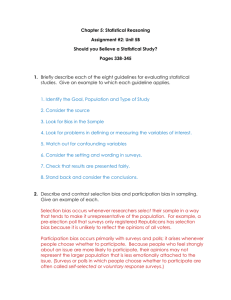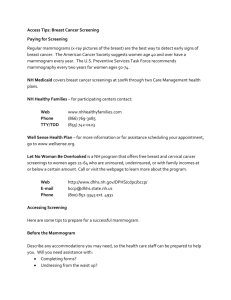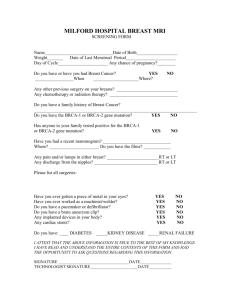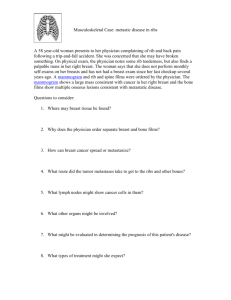Seeing Through Statistical Studies Seeing Through Statistical Studies
advertisement
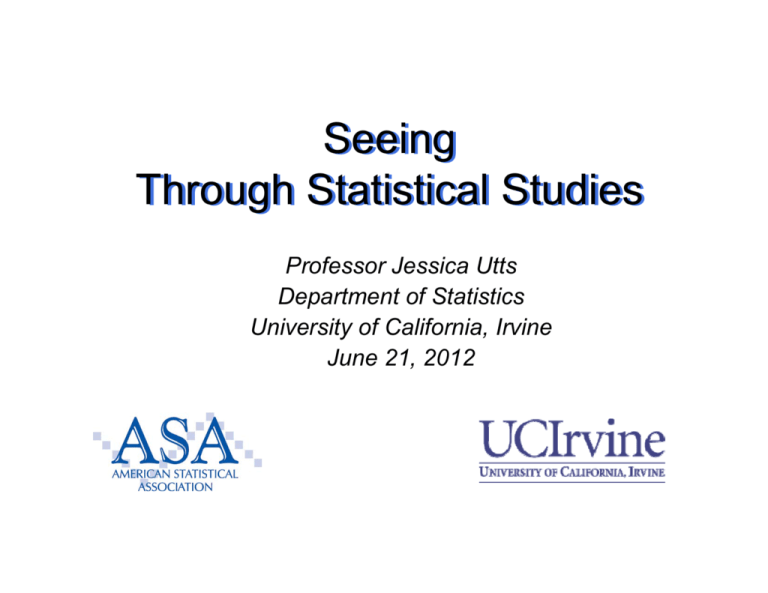
Seeing Through Statistical Studies Professor Jessica Utts Department of Statistics University of California, Irvine June 21, 2012 Topics 1. 2. 3. 4. 5. 6. Surveys and polls – good and not so good Correlation versus causation: how to know Relationships - real or just by chance? Many-fold increase in risk versus high risk Why many studies find conflicting results Poor intuition about probability and chance Note: Many examples in this talk are from my textbook, Seeing Through Statistics The Beauty of Surveys and Polls When Done Right With proper sampling methods, based on a sample of about 1000 adults we can almost certainly estimate, to within 3%, the percentage of the entire population who have a certain trait or opinion. This result does not depend on how large the (large) population is. It could be tens of thousands, millions, billions…. (1000 and 3% is just an example; % depends on the size of the sample. 3% = margin of error) Estimating a Population Percent from a Sample Survey: Margin of Error For a properly conducted sample survey: The sample percent and the population percent rarely differ by more than the margin of error. They do so in fewer than 5% of surveys (about 1 in 20). 1 (Conservative) Margin of error ≅ ×100% n where n is the number of people in the sample. Example: June 7-11, Reuters Poll of n = 848 registered voters asked: "If the election for U.S. Congress were held today, would you vote for the Democratic candidate or the Republican candidate in your district where you live?" Results: Results: Democrat Democrat 47% 47% Margin of error is Republican Neither/Unsure Neither/Unsure Republican 44% 9% 44% 9% 1 = 0.034 or 3.4% 848 So results for the two parties are within the margin of error. Bias: How Surveys Can Go Wrong Results based on a survey are biased if the methods used to obtain those results would consistently produce values that are either too high or too low. Selection bias occurs if the method for selecting participants produces a sample that does not represent the population of interest. Nonparticipation (nonresponse) bias occurs when a representative sample is chosen but a subset cannot be contacted or doesn’t participate (respond). Response bias (biased response) occurs when participants respond, but they provide incorrect information, intentionally or not. Extreme Selection Bias: A meaningless poll Responses from a self-selected group or volunteer sample usually don’t represent any larger group. Example: “Do you support the President’s economic plan?” TV Station call-in poll Yes (support plan) No (don’t support plan) 42% 58% Proper survey 75% 18% Not sure 0% 7% Those dissatisfied more likely to respond to TV poll. Also, it did not give the “not sure” option. Sources of Response Bias 1. 2. 3. 4. 5. 6. 7. Deliberate bias Unintentional bias Desire to please Asking the uninformed Unnecessary complexity Ordering of questions Confidentiality and anonymity Deliberate Bias Questions can be deliberately worded to support a certain cause. Example: Estimating what % think abortion should be legal • Anti-abortion group’s question: “Do you agree that abortion, the murder of innocent beings, should be outlawed?” • Pro-choice group’s question: “Do you agree that there are circumstances under which abortion should be legal, to protect the rights of the mother? Appropriate wording should not indicate a desired answer. Asking the Uninformed People do not like to admit they don’t know what you are talking about. 1995 Washington Post poll #1: 1000 randomly selected respondents asked this question about the non-existent 1975 Public Affairs Act: “Some people say the 1975 Public Affairs Act should be repealed. Do you agree or disagree that it should be repealed?” 43% of sample expressed an opinion – with 24% agreeing and 19% disagreeing. Source: Morin, Wash. Post Weekly, 10-16 April 1995, p. 36. Example, continued… 1995 Washington Post poll #2: Two groups of 500 randomly selected respondents. Group 1: “President Clinton said that the 1975 Public Affairs Act should be repealed. Do you agree or disagree?” Group 2: “The Republicans in Congress said that the 1975 Public Affairs Act should be repealed. Do you agree or disagree?” Group 1: 36% of Democrat respondents agreed, only 16% of Republican respondents agreed. Group 2: 36% of Republican respondents agreed, only 19% of Democrat respondents agreed Topic 2: Can cause and effect be concluded? Randomized experiment: Researchers • Create differences in groups • Observe differences in response Example: Randomly assign women to take HRT or not, observe and compare heart disease rates Observational study: Researchers • Observe differences in groups • Observe differences in response Example: Ask women if they take HRT or not, observe and compare heart disease rates Can cause and effect be concluded? • Observational studies are sure to have confounding variables that can’t be separated from the variables of interest. • Randomized experiments help to even out confounding variables across groups. Example: Explanatory variable: Hormones or not Response variable: Heart disease or not Possible confounding variables: Level of health care, amount of exercise, diet, general attitude toward one’s health, etc. Examples for Discussion Explanatory variable and response variable? Observational study or randomized experiment? Possible confounding variables? • A NEJM study found that members of households with guns were 2.7 times more likely to experience a homicide than those in households without guns. • The Abecedarian Project (UNC) randomly assigned poor infants to receive full-time, educational child care until kindergarten, or not. Those with child care were almost 4 times as likely to graduate from college (23% vs 6%); there were many other differences too. Assessing possible causation Some features that make causation plausible: • There is a reasonable explanation for how the cause and effect would work. • The association is consistent across a variety of studies, with varying conditions. • Potential confounding variables are measured and ruled out as explanations. • There is a “dose-response” relationship. Topic 3: Real Relationships or Chance? Does eating cereal produce boys? • Headline in New Scientist: “Breakfast cereal boosts chances of conceiving boys” Numerous other media stories of this study. • Study in Proc. of Royal Soc. B showed of women who ate cereal, 59% had boys, or women who didn’t, 43% had boys. • Problem #1: Headline implies eating cereal causes change in probability, but this was an observational study. Confounding likely! The Problem of Multiple Testing • The study investigated 132 foods the women ate, at 2 time periods for each food = 264 possible tests! • By chance alone, some food would show a difference in birth rates for boys and girls. • Main issue: Selective reporting of results when many relationships are examined, not adjusted for multiple testing. Quite likely that there are “false positive” results. Common Multiple Testing Situations • Genomics: “Needle in haystack” – looking for genes related to specific disease, testing many thousands of possibilities. • Diet and cancer: Ask cancer patients and controls about many different dietary habits. • Interventions (e.g. Abecedarian Project*): Look at many different outcomes and compare them for the groups that had different interventions. *In this case there were too many differences to be explained by chance. Multiple Testing: What to do? If you read about a study and suspect multiple testing is a problem: • There are statistical methods for handling multiple testing. See if the research report mentions that they were used. • See if you can figure out how many different relationships were examined. • If many significant findings are reported (relative to those studied), it’s less likely that the significant findings are false positives. Topic 4: Avoiding Risk May Put You in Danger • In 1995, UK Committee on Safety of Medicines issued warning that new oral contraceptive pills “increased the risk of potentially life-threatening blood clots in the legs or lungs by twofold – that is, by 100%” over the old pills • Letters to 190,000 medical practitioners; emergency announcement to the media • Many women stopped taking pills. Clearly there is increased risk, so what’s the problem with women stopping pills? Probable consequences: • Increase of 13,000 abortions the following year • Similar increase in births, especially large for teens • Additional $70 million cost to National Health Service for abortions alone • Additional deaths and complications probably far exceeded pill risk. Risk, Relative Risk and Increased Risk • The “twofold” risk of blood clots was a change from about 1 in 7000 to 2 in 7000 – not a big change in absolute risk, and still a small risk. • Absolute risk, relative risk and increased risk – Absolute risk: The actual risk; in this case 2 out of 7000 were likely to have a blood clot – Relative risk: How much the risk is multiplied when comparing two scenarios, double in this case – Increased number at risk: Change in number at risk; from 1 in 7000 to 2 in 7000 in this case Considerations about Risk • Changing a behavior based on relative risk may increase overall risk of a problem. Think about tradeoffs. • Find out what the absolute risk is, and consider relative risk in terms of additional number at risk Example: Suppose a behavior doubles risk of cancer Brain tumor: About 7 in 100,000 new cases per year, so adds about 7 cases per 100,000 per year. Lung cancer: About 75 in 100,000 new cases per year, so adds 75 per 100,000, more than 10 times as many! Topic 5: Why Do Studies Find Conflicting Results? Ioannidis (2005) looked at replication: • 45 high-impact medical studies in which treatments were found to be effective – Each published in top medical journal, and had been cited more than 1000 times – Studies were repeated with same or larger size, and same or better controls for 34 of them. • How many do you think replicated original result of effective treatment? All? Most? Conflicting results, continued The 45 studies included 6 observational studies and 39 randomized controlled trials. Replication results: • Only 20 of the 45 attempted replications were successful (i.e. found the same or better effect) • Of the 6 observational studies, 5 found smaller or reversed effects (83%). • Of the 39 randomized experiments, 9 found smaller or reversed effects (23%). Possible explanations Ioannidis suggests these explanations: • Confounding variables in observational studies • Multiple testing problems in the original studies • Multiple researchers looking for a positive finding; by chance alone, someone will find one Other possible explanations: • Different conditions or participants (different ages, incomes, etc.) in the two studies • Successful replications less likely to be published than unsuccessful ones – “nothing new” Topic 6: Poor intuition about probability and chance • William James was first to suggest that we have an intuitive mind and an analytical mind, and that they process information differently. • Example: People feel safer driving than flying, when probability suggests otherwise. • Psychologists have studied many ways in which we have poor intuition about probability assessments. Example: Confusion of the Inverse Gigerenzer gave 160 gynecologists this scenario: • About 1% of the women who come to you for mammograms have breast cancer (bc) • If a woman has bc, 90% chance of positive test • If she does not have bc, 9% chance of positive test (false positive) A woman tests positive. What should you tell her about the chances that she has breast cancer? Answer choices: Which is best? • The probability that she has breast cancer is about 81%. • Out of 10 women with a positive mammogram, about 9 have breast cancer. • Out of 10 women with a positive mammogram, about 1 has breast cancer. • The probability that she has breast cancer is about 1%. Answer choices and % who chose them • 13% chose “The probability that she has breast cancer is about 81%.” • 47% chose “Out of 10 women with a positive mammogram, about 9 have breast cancer.” [Note that this is 90%.] • 21% chose “Out of 10 women with a positive mammogram, about 1 has breast cancer.” [Note that this is 10%.] • 19% chose “The probability that she has breast cancer is about 1%.” Correct answer is just under 10%! Let’s look at a hypothetical 100,000 women: Test positive Test negative Disease 900 (90%) 100 No disease 8910 (9%) 9810 90,090 90,190 Total Total 1000 (1%) 99,000 100,000 Physicians confused two probabilities: • Probability of positive test, given cancer (90%) • Probability of cancer, given positive test = 900/9810 = 9.2% Confusion of the inverse: Other examples Cell phones and driving (2001 study): • Given that someone was in an accident: – Probability that they were using cell phone was .015 (1.5%) – Probability that they were distracted by another occupant was .109 (10.9%) – Does this mean other occupants should be banned while driving?? • What we really want is probability of being in an accident, given that someone is on a cell phone, much harder to find! Confusion of the inverse: DNA Example Dan is accused of crime because his DNA matches DNA at a crime scene (found through database of DNA). Only 1 in a million people have this specific DNA. Is Dan surely guilty?? Suppose there are 6 million people in the local area population, so about 6 have this DNA. Then: • Probability of a DNA match, given that a person is innocent is only 5 out of 6 million – very low! • But... probability that a person is innocent, given that his DNA matches is 5 out of 6 – very high! Other Probability Distortions • Coincidences have higher probability than people think, because there are so many of us and so many ways they can occur. • Low risk, scary events in the news are perceived to have higher probability than they have (readily brought to mind). • High risk events where we have think we have control are perceived to have lower probability than they have. • People place less credence on data that conflict with their beliefs than on data that support them. Some Useful Websites http://coalition4evidence.org Nonprofit, nonpartisan organization to increase government effectiveness through rigorous evidence of what works in areas of social policy http://www.harding-center.com Harding Center for Risk Literacy (Gerd Gigerenzer) http://stats.org (George Mason University) Nonprofit, nonpartisan, discussions of use and abuse of statistics in the media and public policy QUESTIONS? Contact info: jutts@uci.edu http://www.ics.uci.edu/~jutts


